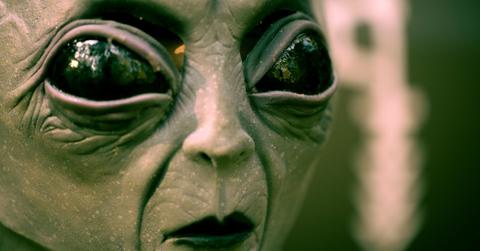We Identify the Planet 'Teeming' With Aliens — As Scientists Declare They Are 99.7 Percent Certain It Is Filled With ETs

The aliens inside were not friendly.
April 17 2025, Published 6:30 p.m. ET
Top scientists have detected potential signs of alien life on a distant planet.
RadarOnline.com can reveal researchers at Cambridge University in the U.K. claim their findings indicate a "99.7 percent probability" that extra-terrestrial life exists.

A report said a group of soviet soldiers encountered the UFO.
Professor Nikku Madhusudhan, who led the Cambridge team at the Institute of Astronomy, made the discovery using NASA's James Webb Space Telescope which launched on Christmas Day in 2021.
He said: "This is the strongest evidence yet there is possibly life out there."
It's all taking place on a so-called Hycean world — a planet with a watery ocean and a thick hydrogen atmosphere.
Hycean comes from combining "hydrogen" and "ocean" together.
"If it is indeed a Hycean world, the planet would be covered in oceans," Professor Madhusudhan added.
The findings mark the second time that life-linked molecules have been observed on exoplanet K2-18b, which is 120 light-years away and roughly 2.5 times the size of Earth.
The planet is orbiting a red dwarf star in what is known as the "habitable zone" – considered the most promising location to find life-supporting planets.
Astronomers have picked out a molecule called DMS in the planet's atmosphere.
On Earth, it’s produced by the tiny algae that live in our seas.
These "phytoplankton" are microscopic and can't be seen with the human eye — but in large numbers, show up as colored patches on water.
And similar alien lifeforms might be churning it out on K2-18b.
Professor Madhusudhan added: "There is no mechanism in the literature that can explain what we are seeing without life.
"It's a question humanity has been asking for thousands of years. It's a shock to the system. It takes time to recover from the enormity of it."
Scientific Per Wimmer also talked up the discovery, adding: "Thanks to the miracle of the James Webb Telescope, an enormous 39-meter-diameter telescope launched in 2029, we're now able to see incredible details from the depths of space.
"Through this amazing instrument, we can detect slight changes in the light coming from a very, very distant planet.

Professor Madhusudhan, who led the team of researchers said, 'this is the strongest evidence yet there is possibly life out there'.

"This is truly amazing science alter the composition of the light ever so slightly.
"And from that, scientists can analyze and determine which gases must be present, because certain gases cause that specific misdirection or distortion of the light. It's absolutely incredible science when you think about it.
"Even more fascinating, the gases detected are similar to those produced by plankton and marine life here on Earth.
"Since plankton is a living organism, the presence of these same gases could suggest that life might exist on that distant planet. That's the assumption backed by a 99.7 percent probability."
He added: "What we now know is this: the planet is about two and a half times the size of Earth, it contains a massive amount of water, and it has an atmosphere rich in hydrogen.
"And that is very good news if you’re looking for signs of life."


